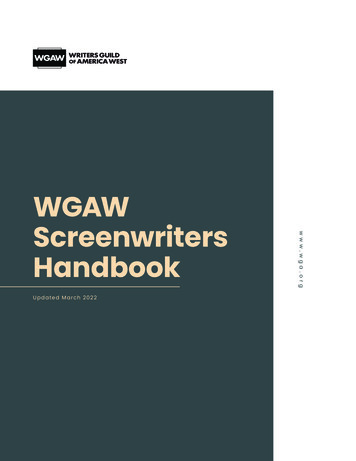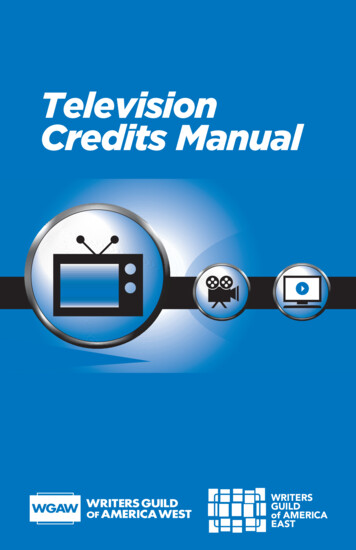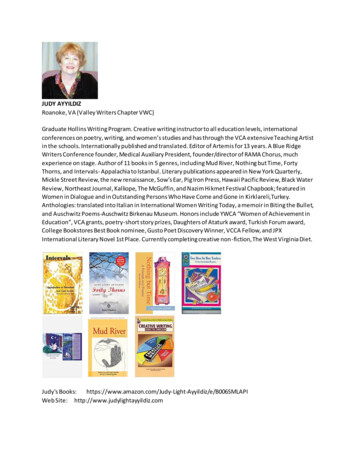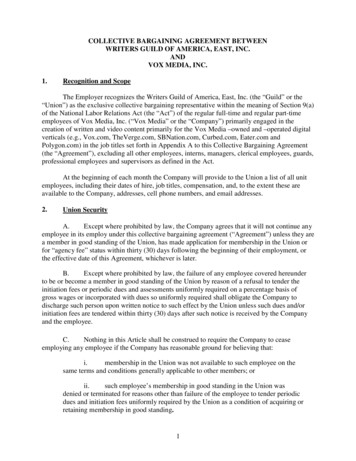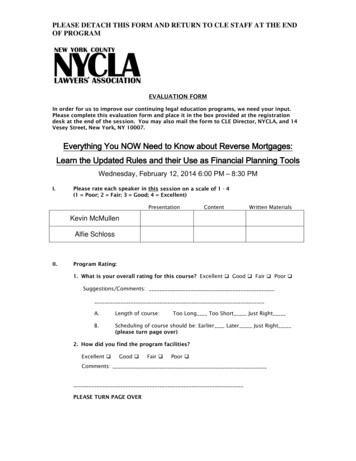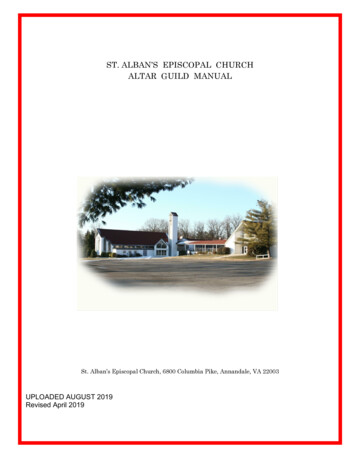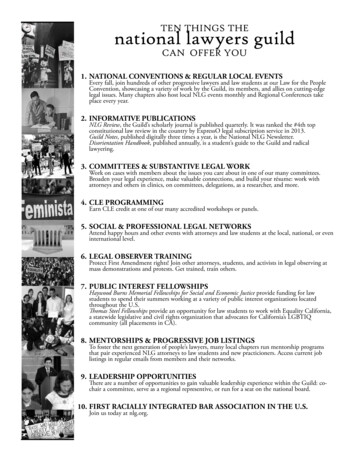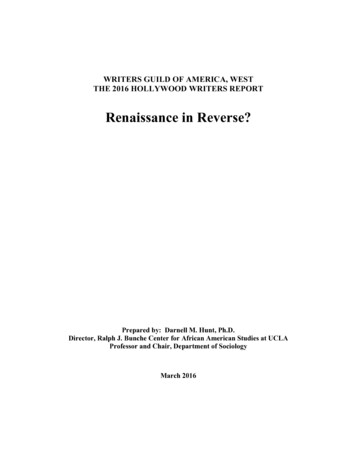
Transcription
WRITERS GUILD OF AMERICA, WESTTHE 2016 HOLLYWOOD WRITERS REPORTRenaissance in Reverse?Prepared by: Darnell M. Hunt, Ph.D.Director, Ralph J. Bunche Center for African American Studies at UCLAProfessor and Chair, Department of SociologyMarch 2016
2TABLE OF CONTENTSList of Tables and FiguresI. BACKROUND AND INTRODUCTION6Organization of the ReportA Note on Other Groups of WritersII. STUDY DATA8Missing DataEarnings StatisticsProduction CompaniesComparing Tables and Figures to earlier Hollywood Writers ReportsIII. OVERALL TRENDS11MembershipEmploymentEarningsConclusionsIV. WOMEN WRITERS17Television EmploymentFilm EmploymentTelevision EarningsFilm EarningsConclusionsV. MINORITY WRITERS20Television EmploymentFilm EmploymentTelevision EarningsFilm EarningsConclusionsVI. OLDER WRITERSTelevision EmploymentFilm EmploymentTelevision EarningsFilm EarningsConclusion25
3VII. SUMMARY AND CONCLUSIONSAPPENDIX: TABLES AND FIGURES30
4LIST OF TABLES AND FIGURESTables:Table 1: Demographic Characteristics of the WGAW Current Membership, Employedand Unemployed Writers, 2014 and 2009Table 2: Current Membership, Employment and Unemployment by Group, 2014 and2009Table 3: Overall Trends in Employment and Earnings by Group, 2008-2014Table 4: Employment Trends by Gender, by Sector, 2008-2014Table 5: Earnings Trends by Gender, by Sector, 2008-2014Table 6: Employment Trends by Race/Ethnicity, by Sector, 2008-2014Table 7: Earnings Trends by Race/Ethnicity, by Sector, by 2008-2014Table 8: Employment Trends by Age Group, by Sector, 2008-2014Table 9: Earnings Trends by Age Group, by Sector, 2008-2014Table 10: Snapshot of Employed Writers, 2014Figures:Figure 1: Current WGA Members, 2007 to 2014Figure 2: Current WGA Members, Female and Minority Shares, 2007 to 2014Figure 3: Employed WGA Writers, 2007 to 2014Figure 4: Median Earnings, Employed Women, Minority, and White Male Writers,2004-2014Figure 5: Women Writers’ Share of Employment, 2010-2014Figure 6: The Gender Earnings Gap, TV, 2009-2014Figure 7: The Gender Earnings Gap, Film, 2009-2014
5Figure 8: Television Employment by Minority Status, 2010-2014Figure 9: Film Employment by Minority Status, 2010-2014Figure 10: The Earnings Gap for Minorities, TV, 2009-2014Figure 11: The Earnings Gap for Minorities, Film, 2009-2014Figure 12: Trends in Minority Employment Share, 1990-2014Figure 13: Employment Rate by Age Group, 2010, 2012, and 2014Figure 14: Share of Television Employment, by Age Group, 2010, 2012, and 2014Figure 15: Share of Film Employment, by Age Group, 2010, 2012, and 2014Figure 16: Television Earnings by Age Group, 2010, 2012, and 2014Figure 17: Film Earnings by Age Group, 2010, 2012, and 2014
6I. BACKGROUND AND INTRODUCTIONThe 2016 Hollywood Writers Report: Renaissance in Reverse? is the tenth in aseries of reports released by the Writers Guild of America, West (WGAW) examiningemployment and earnings trends for writers in the Hollywood industry. These reportshave highlighted three groups of writers — women, minority, and older writers — whotraditionally have been underemployed in the industry. The reports have documented theemployment experiences of these study groups relative to their male, white, and youngercounterparts in order to identify any patterns that suggest either progress or retreat on theindustry diversity front. Using the reports as a diagnostic tool, the WGAW seeks tocollaborate with the industry in efforts to increase the employment opportunities of allwriters.The 2016 report serves as a follow-up to its predecessor, The 2014 HollywoodWriters Report: Turning Missed Opportunities Into Realized Ones. While it focusesprimarily on hiring and earnings patterns for the latest two-year period not covered in theprevious report (i.e., 2013 to 2014), it also includes new analyses of data for the years2009 to 2012 and data for select years imported from previous reports. Prior reports inthe series provide summary data on trends going back to 1982.Organization of the ReportThis report is organized as follows: Section II discusses the sources andlimitations of the data and provides background information on the types of analysesperformed throughout the report; Section III provides a general overview of WGAWmembership, employment, and earnings trends over the study period; Section IV focuseson the experiences of women writers, particularly as they compare to those of their malecounterparts; Sections V and VI present similar, detailed analyses for minority writersand for older writers, respectively; Section VII summarizes the report findings andpresents conclusions.A Note on Other Groups of WritersDepictions of LGBT persons and those with disabilities have increased in filmand television in recent years. Yet questions remain regarding the degree to whichwriters from these groups have been incorporated into the industry workforce,particularly to work on projects for which their perspectives and sensitivities might bemost valued. Indeed, anecdotes suggest that television and film projects featuringdepictions of LGBT persons and those with disabilities all too often fail to employ writersfrom these groups. Beyond the industry experiences reported by select Guild members,however, the data do not currently exist to systematically examine the industry positionsof these groups of writers.The WGAW sponsors member committees that represent the special concerns ofthese groups of writers and that work with the Guild’s Diversity Department to make sure
7that their concerns are addressed by internal Guild programs and industry-Guild,collaborative initiatives. The LGBT Writers Committee has advocated using currentestimates of gay and lesbian representation in the overall population as a benchmarkagainst which to measure the group’s position in the industry. By this logic, at least onein ten voices and perspectives on a project writing staff ideally should be LGBT.Meanwhile, there are only a handful of self-identified writers with disabilities who aremembers of the WGAW. This fact is associated, in part, with the dearth of characterswith disabilities in film and on television. The mission of the Writers with DisabilitiesCommittee is to nurture young writers with disabilities (future WGA members) and toserve as a resource for the whole Guild in matters pertaining to disability. Although oneout of two Americans has a family member or close friend who is disabled, this realityhas yet to be reflected on the big or small screen.In an effort to increase the employment opportunities of all writers, the WGAWannounced a TV Writer Access Program (TV WAP) in January 2009 designed to identifyand connect outstanding screenwriters from each of the diverse communities toshowrunners looking to staff their television shows. Modeled on this television initiative,the Feature WAP was introduced in 2011 for writers seeking exposure to decision makersin the film sector. The WGAW’s goal is to employ data from this report in order tostrengthen the impact of the TV WAP and Feature WAP, as well as collaborate with keyindustry players on rewriting the all-too-familiar story about the challenges faced bydiverse writers.
8II. STUDY DATAThe primary data for The 2016 Hollywood Writers Report come from thecomputerized files of the WGAW, which are based on member reports of employmentand earnings for each quarter. The Guild collects these reports in the normal course ofbusiness for the purpose of establishing member dues. They include information on thenature of the employment (e.g., staff writer, executive story editor, rewrite, developmentdeal, and so on), whether it was provided for the television or film sectors, the companyand/or conglomerate for which the work was completed, and the amount of compensationfor the work. The WGAW also keeps track of basic demographic information on itsmembers, such as gender, ethnicity, birth date, and the year in which each member joinedthe Guild. This demographic information is linked to each work report in thecomputerized files. Six separate datasets — each based on member employment andearnings reports for a specific year between 2009 and 2014 — were analyzed to producethis report.Because the cases examined in this report essentially constitute entire populationsof interest (i.e., “current Guild members,” “employed television writers,” “employed filmwriters,” and so on), inferential statistics are unnecessary for making distinctions betweengroups and are thus not used.Missing DataDespite Guild efforts to collect basic demographic information on its members,some members choose not to identify their gender and/or ethnicity. In the 2014 earningsdataset, for example, less than 1 percent of the cases had missing information for gender,while about 5 percent had missing information for age and about 16 percent for ethnicity.Whenever feasible, the first name of members was used to identify gender for caseswhere the information was missing. Since an analysis of cases with missing ethnicityinformation revealed that these cases were more similar to white writers in terms ofearnings than to other writers, and because research suggests that minority respondentsgenerally are less likely to omit ethnicity information than non-minorities, cases withmissing ethnicity information were coded as “white” for the purposes of analysis (whichfollows the practice employed in earlier Hollywood Writers Reports). Cases withmissing age information were singled out and examined separately in some of the tablesthat summarize age differences in employment and earnings. In other tables that examinethese differences, the year a member joined the Guild was used to approximate age if theexact age of a member was missing. That is, if the data show that a given member joinedthe WGAW 20 years or more prior to the year for which employment and earnings werebeing reported (i.e., prior to 1994 in the 2014 data set), it was assumed that the memberwas more than 40 years old in the report year (i.e., the case was coded as “over 40 agen/a”).
9Earnings Statistics“Median” earnings statistics are used throughout this report to compare earningstrends among different groups of writers: non-minority writers, minority writers, whitemale writers, female writers, writers over 40 years of age, writers under 40 years of age,and so on.1The “median” refers to the value physically in the middle of a ranked distributionof numbers. Like the “mean” or arithmetic “average,” it is a measure of what is typicalfor a given distribution of numbers. But unlike the mean or average it has the advantageof not being unduly influenced by extremely high or extremely low values, which mightotherwise produce a distorted view of what is typical for the distribution. For thesereasons, the median is conventionally used to examine income distributions, as they oftencontain very low and/or very high values. In this report, the median is the primarymeasure used to identify any meaningful earnings differences between the differentgroups of writers.The “95th percentile,” by contrast, provides us with a measure of what the highestpaid writers in a particular group of writers earned in a given year. That is, only 5percent of writers in a given group earned this amount or more, while 95 percent earnedless. Using this statistic provides us with another way of thinking about any earningsdifferences between the groups: To what degree do earnings differences between thegroups exist when we consider only the writers who are at the very top of the profession?“Relative earnings” statistics are ratios used in some tables to compare a group’searnings at the median or 95th percentile to those of another referent group. In this report,the earnings of women and minorities (numerator) are reported in relation to those ofwhite males (denominator), while the earnings of writers over 40 (numerator) arereported relative to those of writers under 40 (denominator). When the ratio is below 1.00, the group in question earns less than the referent group; when it is above 1.00, thegroup earns more.For reasons of writer confidentiality and because both the median and 95thpercentile statistics are less reliable when the number of observations is low, earningsstatistics are reported for a given group of writers only when there are five or moreobservations.1While member-reported film earnings reflect the total earnings of writers from filmemployment, television earnings are reported on all script fees and on approximately thefirst 6,500 earned per week by television writers employed in additional capacities.
10Production CompaniesDue to changes in media ownership in recent years, this report omits theproduction company analyses presented in earlier reports. Future reports in this serieswill consider employment and earnings statistics for each group of writers byconglomerate and larger independent production company.Comparing Tables and Figures Across Hollywood Writers ReportsThe WGAW member reports on which this study is based are received by theGuild on a continual basis, sometimes significantly beyond the year in which the workwas performed. For this reason, each of the six yearly data sets used to compile thisreport’s tables may be adjusted in future reports as new member information is receivedby the Guild. By contrast, data reported herein for years prior to 2009 have not beenupdated and thus conform to those presented in tables from the previous report.
11III. OVERALL TRENDSThe 2016 Hollywood Writers Report provides an update on the progress ofwomen, minority, and older writers on the employment and earnings fronts. Relative totheir white male and younger counterparts, these groups of writers have traditionallyfaced underemployment and/or lower earnings in Hollywood’s television and filmsectors. This report focuses on changes in the groups’ prospects since 2012, which mustbe considered in the context of major trends in the Hollywood industry. One of the mostimportant industry trends is the volume of film and television production. Whiletheatrical film production among the major studios has declined significantly since 2006,2the explosion in original programming across broadcast, cable, and digital platforms hasushered in a renaissance in television. Indeed, the increase in jobs in the television sectorhas more than offset the losses in film in recent years. How have women, minority andolder writers fared in this expanding Hollywood context?The previous report — which considered employment and earnings through 20123— found modest progress for women and minorities in television, and gains for olderwriters in film. It noted that women writers had reduced the gender earnings gap intelevision, despite a small decline in the group’s share of sector employment. Bycontrast, the report found that minority television writers had posted small increases inemployment share and earnings relative to their white male counterparts by 2012. In thefilm sector, however, the report found stagnation for both women and minority writers asneither group had gained any ground on their white male counterparts. As a result, bothgroups remained seriously underrepresented among the corps of writers in both sectors.Meanwhile, the report noted that older writers (particularly those aged 41 to 50) claimedthe largest share of employment in television and film in 2012, as well as the highestearnings in each sector.The current report reveals a mixture of slow, forward progress, stalls and reversalson the Hollywood diversity front. Women writers have made small advances intelevision employment and earnings since 2012. Though women writers also made smallgains in film employment, the report reveals they lost ground in sector earnings by 2014.For minority television writers, however, any advances in employment share and relativeearnings have stalled since the previous report. Only in the film sector have minoritywriters enjoyed any gains since 2012 — a slight increase in their share of employmentand a small closing of the earnings gap. Meanwhile, the corps of employed writers intelevision and film has continued to age since the last report. Older writers aged 51 to 602The number of films released by the major studios declined from 204 in 2006 to just136 in 2014, a 33.3 percent decrease (see Theatrical Market Statistics, 2014, p. 21,Motion Pictures Association of America). Meanwhile, the number of writers employedin the film sector dropped 16.3 percent over the same period, from 1922 in 2006 to 1608in 2014 (see Table 4 from the 2014 and 2016 Hollywood Writers Report).3The 2014 Hollywood Writers Report considered employment and earnings in televisionand film through 2012. It can be accessed on-line at:http://www.wga.org/uploadedFiles/who we are/HWR14.pdf
12became the highest paid television writers among the age groups by 2014, while writersaged 41 to 50 remained the highest paid in the film sector.Below, key findings from The 2016 Hollywood Writers Report are summarized inorder to document in greater detail recent trends in employment and earnings for women,minority, and older writers. The WGAW’s goal is to employ these data to diagnosespecific areas in need of intervention so that it can collaborate with key industry playersto facilitate progress on the industry diversity front.MembershipOver the six-year period 2009 to 2014, the number of WGAW current membersincreased 2.4 percent, from 8499 to 8704 (see Table 1). This growth in Guildmembership over the most current period builds on the smaller .9 percent increasebetween 2007 and 2012 noted in the previous Hollywood Writers Report. Figure 1shows that current membership has steadily increased since 2007, before peaking in themost recent year examined in this report. Despite the upturn since 2007, membershipnumbers would have to increase another 4 percent in order to reach the figure of 9056seen in 2000.Changes in WGAW membership between 2009 and 2014 were not evenlydistributed across the study groups (see Table 1). The overall number of minoritycurrent members increased 15.4 percent over the period (from 777 to 897 members),despite a decline in African American current members (from 361 to just 326) ! theonly minority group to register a decline in membership. Overall, minority writerscomprised 10.3 percent of current WGAW members in 2014, up just about a percentagepoint from the group’s 9.1 percent share in 2009. (Figure 2 charts the trend in minorityshare of current membership since 2007, when it stood at 7.8 percent.) The share ofcurrent membership claimed by women writers was also up slightly over the period, from24 percent in 2009 to 24.9 percent in 2014. (Figure 2 shows that female share of currentmembership has hovered at around 24 percent since at least 2007.) By contrast, thewhite/other share of current membership declined a bit over the study period, from 90.9percent in 2009 to 89.7 percent in 2014 (see Table 1).Meanwhile, Guild membership continued to age relative to previous years. Thelargest group of older current members, those aged 41 to 50, registered a 3.1 percentincrease in its numbers over the period (from 2390 to 2463 members), while the largestgroup of younger members, those aged 31 to 40, posted an 8.5 percent decline in itsnumbers over the period (from 2203 to 2016 members). It should be noted that largestincrease in current membership among the age groups was posted by members aged 61 to70 (25.1 percent), followed by those aged 71 to 80 (24.6 percent). The youngest group ofGuild members, those younger than 31, increased its numbers by 18.8 percent over theperiod (from 325 to 386 members). As a result of these changes, the membership shareof writers over 40 increased from 68.2 percent in 2009 to 70.9 percent in 2014.
13When minority status, gender, and age are considered simultaneously (see Table2), we find that white males over 40, as in the previous report, posted the largest increasein the share of current Guild membership ! 1.7 percentage points (from 47.3 percent in2009 to 49 percent in 2014). By contrast, white males 40 and under posted the largestsingle decline in current membership, 2.4 percentage points (from 19 percent in 2009 to16.6 percent in 2014). The figures for all other groups indicate smaller increases ordecreases in current membership share between 2009 and 2014 or they remain flat.EmploymentThe number of employed writers increased 12.4 percent between 2009 and 2014,dwarfing the 2.2 percent uptick between 2007 and 2012 noted in the previous report.That is, there were 4983 writers employed in 2014, compared to just 4432 in 2009 (seeTable 1). As Figure 3 shows, overall employment plummeted after 2007, reaching itsnadir of 4189 writers in 2008, before commencing a steady rise in subsequent years.Between 2008 and 2009 alone, overall employment increased 5.8 percent (from 4189 to4432 writers). Employment increases for minority writers were even more marked (seeTable 1). Between 2009 and 2014, the number of employed minority writers increased41.4 percent, from 425 to 601 writers. This increase in the number of employed minoritywriters continues a recent trend first noted in the 2011 Hollywood Writers Report.But when minority groups are considered separately, it becomes clear that not allgroups advanced equally over the period. That is, while the numbers of employed Latinoand Asian writers increased markedly over the period (by 64.5 percent and 42.9 percent,respectively), the number of employed African American writers increased by a moremodest 12.6 percent and the already small number of employed Native writers actuallydropped by 44.4 percent.4Among the age groups, employment numbers were flat for younger writers aged31 to 40, while for the oldest writers, those 81 and over, employment dropped 16.7percent between 2009 and 2014. All other age groups enjoyed increases in employmentover the period. Writers aged 61 to 70 led the way with a 57.1 percent increase inemployment, while those aged 51 to 60 (27.5 percent increase), younger than 31 (26.4percent increase), 71 to 80 (25.9 percent increase), and 41 to 50 (13.7 percent) followed.Consistent with earlier findings about the recent rebound in employment forwriters, Table 2 shows that the overall employment rate (i.e., “percent employed”) for2014 was 57.2 percent, up about 5 percentage points from the 52.1 percent figure for2009. This dwarfs the .7 percentage point increase noted in the 2014 Hollywood WritersReport for the previous 5-year study period (i.e., 2007 to 2012). Moreover, when weconsider white males, white women, minority males, and minority women separately, itbecomes clear that each group enjoyed increases in employment rate over the period.Minority and women writers enjoyed the largest increases. Specifically, the overall4Note that trends for multiracial writers will be considered in subsequent reports due tothe recent inclusion of the multiracial category in study data.
14employment rate for minority women increased more than 18 percentage points between2009 and 2014 (from 54.5 percent in 2009 to 72.9 percent in 2014), while the overallemployment rates for minority males and white women increased 8 percentage points(from 54.8 percent to 62.8 percent) and 6.1 percentage points (from 51.9 percent and 58percent), respectively. By contrast, the overall employment rate for white male writersincreased a more modest 3.7 percentage points between 2009 and 2014 (from 51.9percent to 55.6 percent). As we would expect given Guild requirements for newmembership, the employment rates for younger members of each group weresignificantly higher than those for their older counterparts.Table 3 compares the number of employed writers from key study groups, byyear, between 2008 and 2014. It also presents each group’s share of overall employmentin any given year. Each group posted increases in the number employed over the studyperiod, but the biggest winners were minority writers, over-40 writers and womenwriters. Minority writers enjoyed a 63.3 percent increase in employment over the period(from 368 writers in 2008 to 601 in 2014), while over-40 writers and women writersposted increases in employment of 31.5 percent (from 2233 to 2936 writers) and 31percent (from 1000 writers to 1310 writers), respectively. As a result, each of thesegroups registered a sizable increase in its share of overall employment between 2008 and2014 ! from 51.2 percent to 58.9 percent of all employment for over-40 writers5, from8.4 percent to 12.1 percent for minority writers, and from 22.9 percent to 26.3 percent forwomen writers. Employment gains for white male writers and 40-and-under writers weremore modest. That is, white males posted a 12.5 percent increase in employment (from2968 to 3339 writers) and 40-and-under writers followed with the smallest increase inemployment, 10.1 percent (from 1634 to 1799 writers).EarningsOverall median earnings increased 17.4 percent between 2008 and 2014, from 106,470 to 125,000. Consistent with findings from the previous report, writers over 40were the highest earning group in 2014, with median earnings of 141,884 (see Table 3).By contrast, the median earnings figure for white males in was just 133,500 in 2014.Indeed, median earnings for writers over 40 increased 41.9 percent between 2008 and2014, compared to just 16.4 percent for those of white male writers. While the earningsof women and minority writers continued to lag behind those of white male and olderwriters, both groups posted notable increases in earnings over the six-year period: theearnings of women writers increased 31.5 percent to 118,293 in 2014, and those ofminority writers increased 18.2 percent to 100,649. As a result of these developments,women writers earned 89 cents for every dollar earned by their white male counterpartsin 2014, while minority writers earned 75 cents. It’s worth noting that relative earningsfor minority writers peaked in 2002, when they earned 90 cents for every dollar earned by5Note: The totals for over-40 and under-40 writers do not sum to 100 percent in thistable due to missing values for age; thus the magnitude of the increase noted for olderwriters over the period should be read as an estimate of the actual figure.
15their white male counterparts ! roughly!the same as women in 2014. Finally, olderwriters earned 1.34 for every dollar earned by their younger counterparts in 2014.Group differences in earnings, as also noted in previous reports, were generallymore pronounced for the most highly paid writers. As in the previous report, Table 3shows that women writers posted the largest increase in earnings over the period at the95th percentile (18.3 percent), followed by minority writers who enjoyed a 12.6 percentincrease in earnings at the 95th percentile. Still, white males continued to dominateamong the highest paid writers in 2014 with earnings of 646,202 at the 95th percentile,followed closely by over-40 writers with earnings of 642,301. The 95th percentileearnings for the other groups were considerably lower in 2014: 447,097 for women, 445,853 for writers 40 and under, and 386,885 for minority writers ! who, as in theprevious report, held up the rear. Relative to their white male counterparts that year,women writers and minority writers earned about 69 cents and 60 cents on the dollar atthe 95th percentile, respectively.White Males Continue to Dominate in Overall Earnings; Women and Minorities Gain NoGroundThe previous report noted small gains for women and minority writers in overallmedian earnings relative to their white male counterparts. But as Figure 4 shows, neithergroup has gained any ground on white men since 2012, the last year considered in theprevious report. In 2014, overall median earnings for women were 118,293, comparedto 133,500 for their white male counterparts. The resulting gender gap in overallearnings of 15,207 that year was actually a bit larger than the 14,272 gap evident in2012. For minorities, the overall earnings gaps were nearly identical in 2014 and 2012! 32,851 and 32,238, respectively. In 2014, minority writers posted overall medianearnings of just 100,649, compared to 133,500 for their white male counterparts. As aresult of these developments, the relative earnings figures for women and minoritywriters were flat between 2012 and 2014. That is, women writers earned 89 cents forevery dollar earned by their white male counterparts in 2012 and 2014, while the figurefor minorities was virtually unchanged at 75 cents on the dollar in 2014 and 76 cents in2012.ConclusionsThe familiar story of male and white dominance told in previous HollywoodWriters Reports still characterized industry employment and earnings patterns in 2014,the last year covered in this report. Some of the key findings:Membership* WGAW current membership increased 2.4 percent between 2009 and 2014,an increase in membership more than double the size of the one noted in theprevious report.
16* As in the previous report, writers aged 61 to 70, writers aged 71 to 80, andminority writers posted the largest gains in WGA membership, while themembership numbers for women increased more modestly between 2009 and2014.* Male writers continued to dominate current membership, accounting for 75.1percent of members in 2014.Employment* The overall number of employed writers increased 12.4 percent between2009 and 2014, dwarfing the 2.2 percent increase for the five-year periodconsidered in the previous report.* The overall number of employed minority writers increased 41.4 percentover the period, due primarily to increases in employment enjoyed by Latinoand Asian American writers.* Male writers accounted for 73.7 percent of industry employment in 2014, downabout a percentage point from the 75 percent share the group claimed in 2012,the last year examined in the previous report.Earnings* Overall median earnings increased 17.4 percent since 2008.*
5 Figure 8: Television Employment by Minority Status, 2010-2014 Figure 9: Film Employment by Minority Status, 2010-2014 Figure 10: The Earnings Gap for Minorities, TV, 2009-2014
